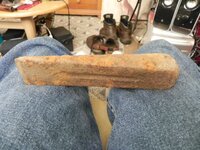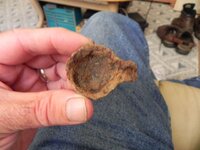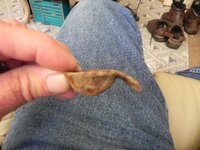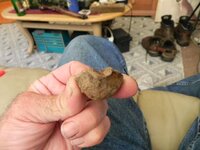Navigation
Install the app
How to install the app on iOS
Follow along with the video below to see how to install our site as a web app on your home screen.
Note: This feature may not be available in some browsers.
More options
You are using an out of date browser. It may not display this or other websites correctly.
You should upgrade or use an alternative browser.
You should upgrade or use an alternative browser.
Ok all you FARMERS out there
- Thread starter worldtalker
- Start date
worldtalker
Gold Member
- Thread starter
- #6
That went through my mind too!NOLA_Ken said:The cup looks like an iron ladle for melting lead. Imagine it with a longer handle.
Upvote
0
Tuberale
Gold Member
Definately a wood-splitting wedge, without the handle for some reason. The whole tool would look similar to an axe. Used to split wood rounds (sections of trunk or branch) into smaller pieces for the fireplace. Should be a hole underneath it where the wooden handle would have fit in.
There are similar-shaped splitting wedges, but those are typically smaller than this. Splitting wedges are solid, have no holes for handle attachment. They are placed in the crack already started then hit with the hammer-portion of the splitting maul. For very large rounds, several wedges can be used together to assure the round splits completely.
I'd tentatively agree the small cup would be a crucible for melting lead or tin. The lip would assist in pouring the lead or tin into a mold, such as for making lead weights or for making lead bullets. After the mold had cooled, it would be split and the newly created lead weights or bullets could be trimmed for use from any excess lead to make them more aerodynamic. Any lead left over would be used again and again.
Seems to be from 2 different centuries here. The lead crucible would be from the 1700-1860 period, when automation made it easier and cheaper to buy pre-formed bullets. The splitting wedge looks to be mostly iron, which most recently has been replaced with a variety of cheaper and lighter components, including fiberglass. If iron, then likely from 1850-1950 period.
There are similar-shaped splitting wedges, but those are typically smaller than this. Splitting wedges are solid, have no holes for handle attachment. They are placed in the crack already started then hit with the hammer-portion of the splitting maul. For very large rounds, several wedges can be used together to assure the round splits completely.
I'd tentatively agree the small cup would be a crucible for melting lead or tin. The lip would assist in pouring the lead or tin into a mold, such as for making lead weights or for making lead bullets. After the mold had cooled, it would be split and the newly created lead weights or bullets could be trimmed for use from any excess lead to make them more aerodynamic. Any lead left over would be used again and again.
Seems to be from 2 different centuries here. The lead crucible would be from the 1700-1860 period, when automation made it easier and cheaper to buy pre-formed bullets. The splitting wedge looks to be mostly iron, which most recently has been replaced with a variety of cheaper and lighter components, including fiberglass. If iron, then likely from 1850-1950 period.
Upvote
0
It looks like a splitting wedge to me not the head of a splitting maul. I heated my previous house for 20 years with wood, started with a sledge hammer and wedges, later went with hydraulic log splitter. the taper on it is less than the newer ones(they are still made but say made in china on them) that taper is much more effective than the newer ones--splits wood rounds easier. No idea on the age .
Upvote
0
Getty said:I think the cup is for pouring lead joints,plumbing. they fill the cast iron joint with oakum and pour lead to seal the joint water tight. I agree it had a long handle.
I think it is too small and thin-walled for smelting lead.
Upvote
0
NOLA_Ken
Gold Member
- Jan 4, 2011
- 5,214
- 4,179
- Detector(s) used
- several, mostly Garrett
- Primary Interest:
- All Treasure Hunting
creskol said:Getty said:I think the cup is for pouring lead joints,plumbing. they fill the cast iron joint with oakum and pour lead to seal the joint water tight. I agree it had a long handle.
I think it is too small and thin-walled for smelting lead.
It may be a bit small to be a plumbers ladle, but not too small for casting bullets.
Upvote
0
- Jun 26, 2008
- 7,786
- 11,136
- Detector(s) used
- Ace 250 (2), Ace 300, Gold Bug 2, Tesoro Cortes, Garrett Sea Hunter, Whites TDI SL SE, Fisher Impulse 8, Minelab Monster 1000, Minelab CTX3030, Falcon MD20, Garrett Pro-pointer, Calvin Bunker digger.
- Primary Interest:
- Metal Detecting
I have some of those wedges. They are avaiable today at most large hardware stores. TTC
Upvote
0
truckinbutch
Silver Member
I have a wood splitting wedge twice or more the size of the one you have . My grandfather used
it to split American Chestnut logs before the blight killed them .
I think the remainder of the ladle you have was for pouring Babbitt bearings .
it to split American Chestnut logs before the blight killed them .
I think the remainder of the ladle you have was for pouring Babbitt bearings .
Upvote
0
worldtalker said:1.500 dia. .100 thk.
That is tiny .. and by scale, it must only be 1/2 inch deep or less, and at only 3/32 of an inch thick , I have my doubts that it was used for smelting.
Upvote
0
digging wv
Sr. Member
Not all splitting wedges have handles! I've used these wedges foe splitting wood for many years. They are also used to help guide a treecut and and also other tasks.
Upvote
0
Bigcypresshunter
Gold Member
- Dec 15, 2004
- 27,000
- 3,339
- Detector(s) used
- 70's Whites TM Amphibian, HH Pulse, Ace 250
- Primary Interest:
- Beach & Shallow Water Hunting
I use a splitting wedge exactly like the one found.
Upvote
0
High Plains Digger
Bronze Member
- Feb 1, 2008
- 1,314
- 13
I agree with all the "splitting wedge" people. I have two and have occasionally driven them to full depth. Cottonwood is a mean, sucky, fiberous wood, especially if it has grown near the water. Definitely no handle or handle holes. All steel, I suppose, rather than iron, but whatever.
Upvote
0
Top Member Reactions
-
 3319
3319 -
 1926
1926 -
 1920
1920 -
 1193
1193 -
 1093
1093 -
 864
864 -
 814
814 -
 811
811 -
 803
803 -
 789
789 -
 773
773 -
 532
532 -
 493
493 -
 476
476 -
 423
423 -
 419
419 -
 419
419 -
E
416
-
 403
403 -
 395
395
Users who are viewing this thread
Total: 2 (members: 0, guests: 2)









